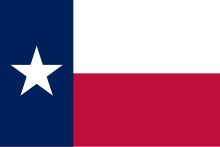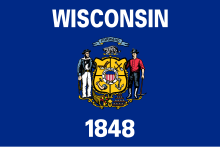1848 in the United States
Appearance
| |||||
| Decades: | |||||
|---|---|---|---|---|---|
| See also: | |||||
| 1848 in the United States |
| 1848 in U.S. states |
|---|
| States |
|
|
| Washington, D.C. |
| List of years in the United States by state or territory |
Events from the year 1848 in the United States.
Incumbents
[edit]Federal government
[edit]- President: James K. Polk (D-Tennessee)
- Vice President: George M. Dallas (D-Pennsylvania)
- Chief Justice: Roger B. Taney (Maryland)
- Speaker of the House of Representatives: Robert Charles Winthrop (W-Massachusetts)
- Congress: 30th
Events
[edit]
January–March
[edit]- January 24 – California Gold Rush: James W. Marshall finds gold at Sutter's Mill, in Coloma, California.
- January 31 – The Washington Monument is established.
- February 2 – Mexican–American War: The Treaty of Guadalupe Hidalgo is signed, ending the war and ceding to the U.S. virtually all of what becomes the southwestern United States.
- February 24 – The University of Mississippi is founded.
- March 18 – The Boston Public Library is founded by an act of the Great and General Court of Massachusetts.

April–June
[edit]- April 3 – The Chicago Board of Trade is founded by 82 Chicago merchants and business leaders.
- April 23 – The Illinois and Michigan Canal is completed.
- May 19 – The Treaty of Guadalupe Hidalgo (February 2), ending the Mexican–American War, is ratified by the Mexican government.
- May 29 – Wisconsin is admitted as the 30th U.S. state (see History of Wisconsin).
- June 14–15 – The Liberty Party National Convention is held in Buffalo, New York. Presidential candidate Gerrit Smith establishes woman suffrage as a party plank.[1][2]
July–September
[edit]- July 19 – Seneca Falls Convention: The first women's rights convention opens in Seneca Falls, New York.
- July 26 – The University of Wisconsin–Madison is founded.
- August 9 – The abolitionist Free Soil Party is founded by former president, Martin Van Buren in Buffalo, New York.
- August 14 – Oregon Territory is established.
- August 19 – California Gold Rush: The New York Herald breaks the news to the East Coast of the United States that there is a gold rush in California (although the rush started in January).
- September 12 – One of the successes of the Revolutions of 1848, the Swiss Federal Constitution, patterned on the U.S. Constitution, enters into force, creating a federal republic and one of the first modern democratic states in Europe.
- September 13 – Vermont railroad worker Phineas Gage incredibly survives a 3-foot-plus iron rod being driven through his head.
- September 20 – The American Association for the Advancement of Science (AAAS) is founded in Philadelphia.

October–December
[edit]- November 1 – The first medical school for women, The Boston Female Medical School (which later merges with Boston University School of Medicine), opens in Boston, Massachusetts.
- November 7 – U.S. presidential election, 1848: Whig Zachary Taylor of Louisiana defeats Democrat Lewis Cass of Michigan in the first U.S. presidential election to be held in every state on the same day.
- December 26 – The Phi Delta Theta fraternity is founded at Miami University.
No fixed date
[edit]- Rhodes College is founded in Clarksville, Tennessee as the Masonic University of Tennessee.
- The Shaker song "Simple Gifts" is written by Joseph Brackett in Alfred, Maine.
Ongoing
[edit]- Mexican–American War (1846–1848)
- California Gold Rush (1848–1855)
Births
[edit]- January 13 – Lilla Cabot Perry, painter (died 1933)
- February 20 – E. H. Harriman, railroad executive (died 1909)
- February 22 – Emily McGary Selinger, painter, author and educator (died 1927)
- March 8 – LaMarcus Adna Thompson, inventor (died 1919)
- March 19 – Wyatt Earp, lawman and gunfighter (died 1929)
- March 26 – Edward O. Wolcott, U.S. Senator from Colorado from 1889 to 1901 (died 1905)
- May 10 – Lafayette Young, U.S. Senator from Iowa from 1910 to 1911 (died 1926)
- June 15 – Sol Smith Russell, comedian (died 1902)
- July 22 – Winfield Scott Stratton, miner (died 1902)
- August 24 – Kate Claxton, actress (died 1924)
- September 4 – Lewis Howard Latimer, African American inventor (died 1928)
- September 29 – Caroline Yale, educator (died 1933)
- October 6 – Webb C. Ball, jeweler and watchmaker from Fredericktown, Ohio (died 1922)
- October 15 – Harmon Northrop Morse, chemist (died 1920)
- November 1 – Caroline Still Anderson, African American physician, educator and activist (died 1919)
- November 2 – Stephen Mallory II, U.S. Senator from Florida from 1897 to 1907 (died 1907)
- November 7 – B. B. Comer, 33rd Governor of Alabama, U.S. Senator from Alabama in 1920 (died 1927)
- November 20 – James M. Spangler, inventor (died 1915)
- November 27 – Henry A. Rowland, physicist (died 1901)
Deaths
[edit]
- February 11 – Thomas Cole, landscape painter (born 1801 in the United Kingdom)
- February 23 – John Quincy Adams, sixth president of the United States from 1825 to 1829 (born 1767)
- March 29 – John Jacob Astor, businessman (born 1763)
- April 29 – Chester Ashley, U.S. Senator from Arkansas from 1844 to 1848 (born 1790)
- May 18 – William Leidesdorff, businessman (born 1810)
- June 26 – Stevenson Archer, U.S. Congressman from Maryland from 1819 to 1821 (born 1786)
- July 20 – Francis R. Shunk, politician (born 1788)
- August 15 – Timothy Olmstead, composer, fifer in the American Revolutionary War (born 1759)
- August 30 – Simon Willard, horologist (born 1753)
- October 25 – Dixon Hall Lewis, U.S. Senator from Alabama from 1844 to 1848 (born 1802)
- December 31 – Ambrose Hundley Sevier, U.S. Senator from Arkansas from 1836 to 1848 (born 1801)
See also
[edit]Further reading
[edit]- The Emigrant's Hand-book, or, A directory and guide for persons emigrating to the United States of America; also, a concise description of the states of Ohio, Indiana, Illinois, Michigan, Wisconsin, Missouri and Iowa, and the western territories, and including a statement of the modes and expenses of travelling from New York to the interior, New York: J.H. Colton, 1848, OCLC 2604051, OL 7235459M
References
[edit]- ^ Claflin, Alta Blanche (1915). Political parties in the United States 1800–1914. New York Public Library. p. 50.
- ^ Wellman, Judith (2000). The Road to Seneca Falls. University of Illinois Press. p. 176. ISBN 0-252-02904-6.
External links
[edit] Media related to 1848 in the United States at Wikimedia Commons
Media related to 1848 in the United States at Wikimedia Commons

